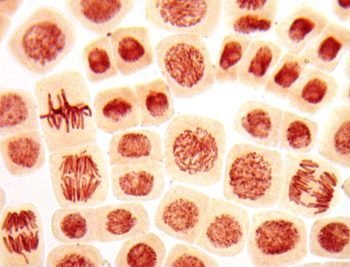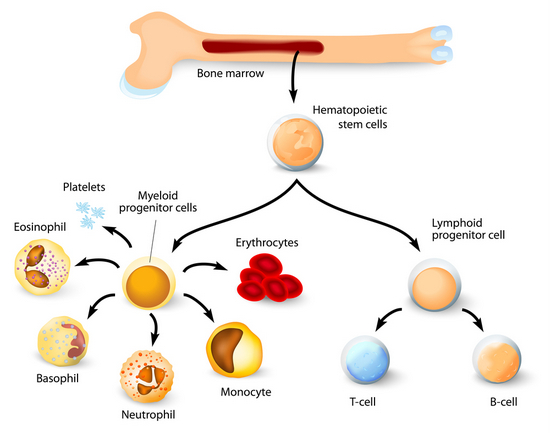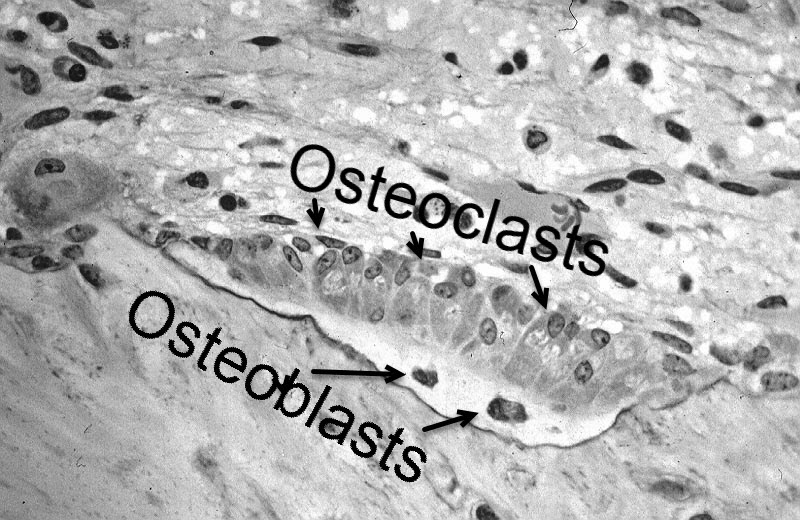Lifespan of body parts
While the general features of human beings can be described with pictures and models of body parts in various degrees of assembly, actual human beings exhibit a great deal of variability that is dictated by their physiology.
In fact, many of your body parts are a different age than your birth age. The process of self renewal is important for you to understand, because its efficiency changes with age.
Dr. Jonas Frisen at the Karolinska Institute in Stockholm used carbon14 that was incorporated into DNA during above ground testing of nuclear weapons prior to 1963 to follow the age of DNA in human tissues [published in Cell 2005 Jul15;122(1):133-43]. Carbon14 is a low intensity radioactive atom that decays slowly with a very long half-life.
Within cells most molecules are constantly being made, destroyed, and parts recycled. An exception is the DNA, the genetic material of the cell. A cell acquires its DNA on the day its parent cell divided, and it is kept intact by repair mechanisms until the cell dies. Repair mechanisms use molecules available at the time to rebuild the DNA. Because the content of DNA is stable over the lifetime of a cell, the extent of carbon14 enrichment of the repair molecules can be used to figure out the age of cells.
There are two ways for a body to produce new cells. The first way, mitosis, is for a particular cell type, such as a liver cell, to divide and produce two new cells that are copies of the original.
The second way is for adult stem cells within tissues to make new replacement cells. There are different types of adult stem cells depending upon where in the body they are located and depending upon what kind of new cell they produce.
Stem cells themselves are present in very low numbers, but once they begin dividing and develop characteristics of the cell type they are replenishing, a single stem cell can produce millions of offspring.
Only a few body parts last most of your lifetime. They are the neurons of the cerebral cortex, the inner lens cells of the eye, and muscle cells of the heart.
In contrast the life span of your white blood cells is very short. Neutrophils can survive 3-4 days unless they digest bacteria. Then they die in about 12 hours. Eosinophils live about 3 weeks. Basophils last about 3-10 days. Red blood cell lifespan is about 120 days.
The life span of B lymphocytes that produce antibodies ranges from 4 days to 5 weeks. T lymphocytes can last either a day or two or for months depending upon their battle with foreign substances. Monocytes and platelets interact in many settings such as inflammation and blood clotting and leave the circulation at random.
The life span of each type of tissue depends upon the workload endured by its cells. Cells lining the acid filled stomach last only about 5 days. The outer layer of skin is recycled about every two weeks. The entire human skeleton is thought to be replaced by bone turnover every 10 years or so in adults.
An adult human liver has amazing powers of regeneration when damaged. However, in normal liver, cell turnover is relatively slow. The liver is a large solid organ that is the first to receive venous flow from the intestine. It acts a central processing center for ingested nutrients and plays a large role in body homeostasis. Normal cell turnover permits the liver to adjust to changes in body weight, which in turn affect homeostatic requirements.
The constant recycling of body tissues due cell lifespan argues that we should provide our bodies with adequate nutrition, exercise, and rest throughout our lifetime. Damage to self renewal processes leads to severe limitations on lifestyle as we age.
Recent theories even suggest that when self renewal processes become damaged or disorganized in a tissue that cancer can be the outcome. There are serious discussions among scientists whether the major player in cancer development is faulty, or lack of, DNA repair and mitosis gone awry, or whether it is adult stem cell tissue replenishment that has gone wide of the mark.
Further reading
Stem Cells: An Evolving Definition
Human Digestion: Main & Accessory Organs
Do you have questions?
I hope you will tell me what you think about this article describing the mixture of ages among your body parts. Please put your questions or comments in the box below or send them to me by email at DrReece@MedicalScienceNavigator.com. I read and reply to all comments and email.
If you find this article interesting, share it with your fellow students or send it to your favorite social media site by clicking on one of the buttons below.
Margaret Thompson Reece PhD, physiologist, former Senior Scientist and Laboratory Director at academic medical centers in California, New York and Massachusetts is now Manager at Reece Biomedical Consulting LLC.
She taught physiology for over 30 years to undergraduate and graduate students, at two- and four-year colleges, in the classroom and in the research laboratory. Her books “Physiology: Custom-Designed Chemistry”, “Inside the Closed World of the Brain”, and her online course “30-Day Challenge: Craft Your Plan for Learning Physiology”, and “Busy Student’s Anatomy & Physiology Study Journal” are created for those planning a career in healthcare. More about her books is available at https://www.amazon.com/author/margaretreece. You may contact Dr. Reece at DrReece@MedicalScienceNavigator.com, or on LinkedIn.
Dr. Reece offers a free 30 minute “how-to-get-started” phone conference to students struggling with human anatomy and physiology. Schedule an appointment by email at DrReece@MedicalScienceNavigator.com.





thanks for the nice information.
Pingback:web2mayhemdownload.org
Wow Excellent blog!
Very helpfull
It is amazing how these systems evolved 😉
I agree. As a supplement to what is written here, recent evidence suggests that even in some parts of the brain new neurons are matured from stem cells during a person’s life span.
good but incomplete information.
Looking for information to present to my kids…..Relevant stuff….as I teach biology to juniors. Nice article…..I will read it to my kids tomorrow.
Do you have information for life span on other organ(s)/cell(s) such as pancreas, heart, lungs, fascia tissue cells, etc. Thanks for the info thus far…please expand it.
Christie heart muscle turns over very little if at all. Fascia and collagen will heal if torn but do so very slowly because they have poor access to circulating blood. Lung and pancreas have several cell types and turnover varies. In human brain only the neurons of the hippocampus turnover at an appreciable rate. In animals the neurons of the olfactory bulb also turnover. The astrocyte population of the brain does not seem to turnover. Microglia of the brain does proliferate but only when the brain experiences damage.
Oh my friend there is no areas of physiology and anatomy that can be any frustrating. Its only celebrations!!!
Now each moment is a new birth and new life.
Therefore we can be celebrating mini birthdays every five days once and mega birthdays every ten years once.
This is a quality work… Its quite comprehensive, i encourage you to do more in your contributiön to knowledge. Thanks
I am interested in meditation and its effect on the body. Could you tell me how does the body remove the dead cell and where does it go?
I think you must be asking about dead brain cells because you mentioned meditation. Is that correct? In the brain dead cells are surrounded and engulfed by macrophage-like brain cells called microglia. Once inside the microglia enzymes digest the parts of the dead neuron and individual molecules released by the digestion are reused by the cell for other purposes. In other parts of the body most dead cells are removed by macrophages of the immune system in a process similar to that used by microglia in the brain.
Thanks for your reply.Could you please tell me when is the cell considered dead?
There are markers that can be seen in fixed tissue with a light microscope that indicate a cell is in a process of dying that is irreversible. They include changes in the morphology of mitochondria and breakdown of the cell’s nucleus. The most obvious dead cells to the eye are skin callouses and at this time of year in New York where I live dry skin flakes.
That was very helpful. Thank you
Would it be possible for some citations for the different life spans of cells?
Here are two references by KL Spalding. You can get a free copy of these papers at these links: http://www.ncbi.nlm.nih.gov/pubmed/23746839 and http://www.ncbi.nlm.nih.gov/pubmed/16009139 The first paper is titled “Dynamics of hippocampal neurogenesis in adult humans” and it was published in 2013. The second paper published in 2005 was titled “Retrospective birth dating of cells in humans”. Both papers were published in the journal Cell.
very informative and useful. Thanks for the article
Your welcome. I am working on a new post about this subject. It will be on the site later this Month. I too think this is a very important subject.
Neat! I love this kind of thing!
Good piece of information.
Whether self-healing process can be accelerated by meditation on a particular organ.
Thank you. This information as well as that included in the Q & A is directly linked to my area of interest. I am especially interested in the adrenal glands, their age related degeneration as well as if any sources can help them respond to healing. Also, how often do the cells replace?
I think you may find some of the information you want by following this link to a Harvard manuscript on this subject http://www.cell.com/developmental-cell/abstract/S1534-5807%2813%2900424-3
Margaret
This is a wonderful article, concise, and written in a “language” we all understand. I wonder if we could apply the same principle regarding the lifespan of a specialized cell (say prostatic cells) would they be benign or cancerous. How long does a prostatic cell usually live?
Thanks
The differentiated cells that behave like stem cells do not become cancerous. I will look up what I can find on turnover of cells in the prostate.
WHAT AN INTERESTING ARTICLE !!!?.TOO CONCISE AND USEFUL.
I looked up for info on lifespan of cell from victim of rape point of view. Had an idea today how to get over physical effects of rape, brain and its memory is different story but to know most of my cells are new set helps to think that I have almost new body by now. Thnx, I’ll share this thought with others, I hope it will help them too.
Justine, that is a very positive way to think. Thank you for sharing that thought.
Very interesting indeed!!!
Thank you for your commitment. Hope you will bring more & more new information about life.
Thanks mam.!
Great post. hugely beneficial. thank you very much for sharing the post madam.
What actually determines the life span of each cell is still not clear to me !
Embryonic cells have all of their gene programs available for use. As an embryo develops into a fetus, various cell types appear when parts of the total program are turned off and other parts of the program are enhanced in their expression. Life span of a particular cell type is determined by the protein/DNA activity within its nucleus, by what type of proteins that activity produces and how hostile an environment the cell experiences.
Why do neurons and muscles cells have longer life span than any other cell in our body? What specifically causes this and why?
The cells that turn over more quickly in the body do so because they usually live in a less protected, more hostile environment. Or, in the case of bone they serve as a reservoir for substances, calcium and phosphate, critical to proper function of the body’s major physiologic controllers, the nervous and cardiovascular systems. The electrical activity of the heart and transmission of signals between neurons are highly dependent upon an adequate amount of extracellular calcium. Phosphate is needed for construction of the energy source ATP. When diet does not provide adequate calcium or phosphate bone is broken down to provide it.
In the article above on the Lifespan of cells, you say “Only a few body parts last ‘most’ of your lifetime. They are the neurons of the cerebral cortex, the inner lens cells of the eye, and muscle cells of the heart”. Are there any cells that are believed to live a persons entire life without reproduction? Also, as far as the neuronal chemicals that hold the code of memory, are they permanent once encoded or are they reproduced (re-remembered) when accessed? Very interesting article and I’m sure I’ll enjoy the other referenced work.
For humans there is little evidence of new neuron formation outside the areas involved in memory formation and recall. Memories are not permanent. Each time a memory, or a fragment of a memory is recalled it is updated with newly acquired information. This is why eyewitness testimony is so unreliable.
It is really a very good article and forward discussion.
What are your sources?
Write me at DrReece@MedicalScienceNavigator.com. The discussion covers multiple sources.
I was on prednisone for 2yrs, 9mo.I’ve been off it for two months. Dx was Left temporal arteritis / Giant cell arteritis, presumed. I am an RN retired and of course I devoured every article I could find in Pubmed on the effects of that steroid. The thing that startled me most was its effect on the ATP cycle and and mitochondria. Is there info re the resumption of natural processes after prednisone is discontinued?
Hi Tula, From a science perspective, it would take a while for the body to readjust to the change. Steroid hormones influence readout of DNA to either enhance or suppress production of particular proteins in target cells. While the cells’ protein population may return to normal over a relatively short period of time with removal of a corticoid like prednisone, restoring normal protein activity would probably take longer. How long would vary by individual. The best reference I could find is at this link https://www.ncbi.nlm.nih.gov/pmc/articles/PMC3722149/
Very interesting articles. How can a doctor tell or what kind of test a doctor used to determine how long a patient with cancer will live?
Can nutritious diet with fresh ingredients help the cells last longer or replace out going cells with better ones?
Doctors do not have tests to tell how long a person will live with or without cancer. For a person with cancer, there are tests to tell if the cancer is present in large enough quantity to be detected and whether the cancer that is present is growing rapidly or slowly. Using that information doctors can guess, based upon statistical averages, what the person’s survival time may be. Those guesses are very inaccurate for a particular person with cancer. Yes, diet and exercise can help cells live longer and replace out going cells with better ones.
Do the newly regenerated hepatic or muscular cells of a patient with insulin resistant are insulin resistant when generated or do they get the disease over time?
Newly formed cells are normal in respect to their complement of insulin receptors. However, how those receptors work, or do not work, depends on other factors such as body weight, exercise and diet.
Hello
Can you tell me when this was published online so I can reference you in an essay
That page was originally published 02/27/2012. I have updated it from time to time since then.
Thank you.
What an absolutely wonderful find this article is. And the questions too are interesting. Margaret what i was looking for is how long glial cells live for? I did look at the link https://www.ncbi.nlm.nih.gov/pubmed/16009139 but it’s very very long and I’m not sure it will give me the information I’m looking for – specifically the lifespan of glial cells.??
Hello Lydia, The information you want is in the article at this link.https://www.medicalsciencenavigator.com/OptimizedPress/neurons-and-brains-other-90-of-cells/ As you will read glia is an umbrella word for several types of neural cells. The linked article is about brain glia. In addition to these glia types are the Schwann cells of the spinal and peripheral nerves which are much like oligodendrocytes of the the brain. All glia in the absence of injury or disease last most of a lifetime after they differentiate from stem cells.
This blog about Lifespan of Human Body Cells: Physiology of Self Renewal has helped me a lot,
is very well written. I used this fat burner product:
https://s96.me/fit and I reached the ideal weight.
Kiss you All!
Thank you for telling me.
Thank you for such a great article that’s informative and simple to understand! I really appreciate it!!!
You said: “Damage to self renewal processes leads to severe limitations on life style.” Can you elaborate more one what you mean by “life style” and what these severe limitations may be?
To live whatever lifestyle you choose, you need a strong healthy body. For example, if the rebuilding of the skeleton fails to occur properly after a break or after its normal breakdown to supply blood calcium, then a fall may result in a life threatening hip fracture. If white blood cells fail to renew properly a person is less likely to fight off infections. Being ill limits what a person may choose to do on a daily basis.
thank you for clarifying! 🙂 It is very true indeed! we need our body to do what we want to do well!
I notice that the parts of our body that has to face the “outer world” or harsh conditions need to be renewed more quickly. e.g. skin, stomach & intestinal lining, is there any information how quickly the cells in the gums and mouth, and also membranes in the lungs need to be renewed?
The cells of the mouth turnover about every 3-6 days with the surface of the tongue having the fastest rate and those of the gums the slowest. Lung tissue replaces slowly over about a year. But when injured the lungs can have a vigorous repair process.
Thank you so much for the valuable information!
I really like what you said: “The constant recycling of body tissues due cell lifespan argues that we should provide our bodies with adequate nutrition, exercise, and rest throughout our lifetime.”
I wish more people would do more to take care of their health!
Not helpful at ALL, I didn’t receive any information about human skin cells, nor human stomach (gut) cells, I was very disappointed my teacher is going to be very mad at me for not finding information bout those cells.
What you are looking for may be on this page https://www.medicalsciencenavigator.com/OptimizedPress/human-digestion-main-accessory-organs/